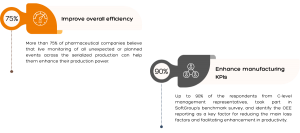
[Blog] How can you optimize all your processes with your already collected production data?
Table of Contents
The storing and processing of information create significant opportunities for improving the overall efficiency
Data is the future. The collection of information is not just for reporting on national systems. The storing and processing of information create significant opportunities and benefits for each company. In the most standard case, we collect and process the information we need, and then report it to the various institutions. But why do we stop there?
Asking this question, we have several opportunities to “reuse” all this data, which we already have at our disposal anyway. You will ask how – pretty simple. You have already an implemented serialization process in your production line that you use for reporting to the national and international authorities. But the collection of serialization data could be used not only for track and trace but also to create a significant beneficial database. Fundamentally, the information that is stored during serialization is of great importance and could serve to improve your manufacturing KPIs and overall efficiency. OEE Reporting is such a tool based on cloud technology that allows pharmaceutical manufacturers to increase production efficiency with real-time monitoring.
What does it mean to use the “already collected” information?
The best way to illustrate is with a real example:
You have a production with the appropriate number of lines that produce a certain number of batches and boxes. You have a “full set” of information about your production. What are you doing with it?
Of course, first of all, the collection of this information is for the purpose of reporting to national systems and is possible thanks to the serialization. But from our experience, we could say that serialization is just the first step.
Having a database for different time periods, for a line or different lines, batches and history of used boxes allows you to analyze the performance and capacity of your equipment. This in turn allows better and more effective data management.
What is the mechanism for production optimization through data?
Having this data, all that is needed is an analytical method based on which to plan and optimize the process subsequently. OEE Reporting provides the opportunity to analyze the performance of the machine in comparison with its theoretical maximum capacity. In other words, it plays the role of a key indicator for the overall efficiency of the equipment, processing the data from all other indicators “under it”.
In order to optimize productivity, the reasons for slow and long-pending lines, errors, downtimes, stops, extended time, etc. must be tracked and found. The OEE is enabled to track all necessary indicators such as:
- Quality and rejection rate
- Unexpected and scheduled downtimes
- Equipment performance monitoring: run-time, setup-time, idle time, downtimes (material shortage, technical, machine maintenance, break/meal time)
- Loss Factors – losses due to speed, short stops, speed imbalances on the line or setup times
- Machine efficiency
- Utilization percentage
- Ideal vs. Actual cycle time
The real-time monitoring of these indicators allows the traceability of the productivity status, compares actual performance and planned targets, identifies key areas that improvements are needed.
Why it is important for the production?
By optimizing the overall efficiency of the equipment, the quality and efficiency of the equipment can be improved.
It`s simple – collecting, storing and visualizing the data across your company, OEE software could in fulfilling your goals and easier realization of production targets.
What are the benefits?
The benefits from this whole process of “data reuse” affect various fields in your company:
- Better understand your business: past and real-time operational data, trends
- Reduce operational costs
- Increase asset performance and drive production results
- Become an active participant in real-time work streams
- Easier realization of production targets
As a final thought, we could tell you that serialization is definitely just the first step. The dynamic development of the traceability world makes it much more than just a track and a trace. Discover your options and benefits from them!



